Mardi Gras Decoration
What Is the Most Famous Drink in New Orleans?
While exploring the lively streets of New Orleans, we can’t ignore the city’s diverse array of flavors and traditions. Within this mix, there is a standout beverage that has become ingrained in the city’s culture.
Its history is as intriguing as the city itself, and its influence has spread far beyond the borders of the Big Easy. So, what is this legendary libation that has captured the hearts and palates of so many?
Well, let's just say that it involves a unique blend of ingredients and a dash of Louisiana charm.
Key Takeaways
- The Sazerac is considered the oldest known American cocktail and has historical significance in New Orleans.
- The Sazerac is made with rye whiskey, absinthe, Peychaud's bitters, and a sugar cube, and the preparation process involves coating a glass with absinthe and stirring the whiskey mixture.
- The Sazerac is a symbol of New Orleans' cocktail culture and heritage, and it reflects the fusion of different cultures and traditions.
- The Sazerac has had a significant economic impact on New Orleans, attracting tourists and supporting the city's hospitality and tourism industries.
The Birth of the Sazerac
When discussing the birth of the Sazerac, it's essential to delve into the rich historical background of this iconic cocktail, tracing its origins to the vibrant city of New Orleans in the early 19th century. The Sazerac is widely regarded as one of the first cocktails ever created, solidifying its place in history. Its birth can be attributed to Antoine Peychaud, a local pharmacist, who concocted the original recipe in the 1830s. The cocktail's origins can be traced to his apothecary, where he blended Sazerac Cognac with his own bitters, creating a unique and flavorful drink that gained immense popularity.
The birth of the Sazerac not only marks the creation of a timeless cocktail but also represents a significant moment in the history of mixology. It symbolizes the fusion of different cultures and traditions, as it evolved from European influences to become an integral part of New Orleans' identity. The Sazerac's cocktail origins are deeply intertwined with the city's rich tapestry, making it a cherished symbol of New Orleans' spirited past.
Key Ingredients of the Sazerac
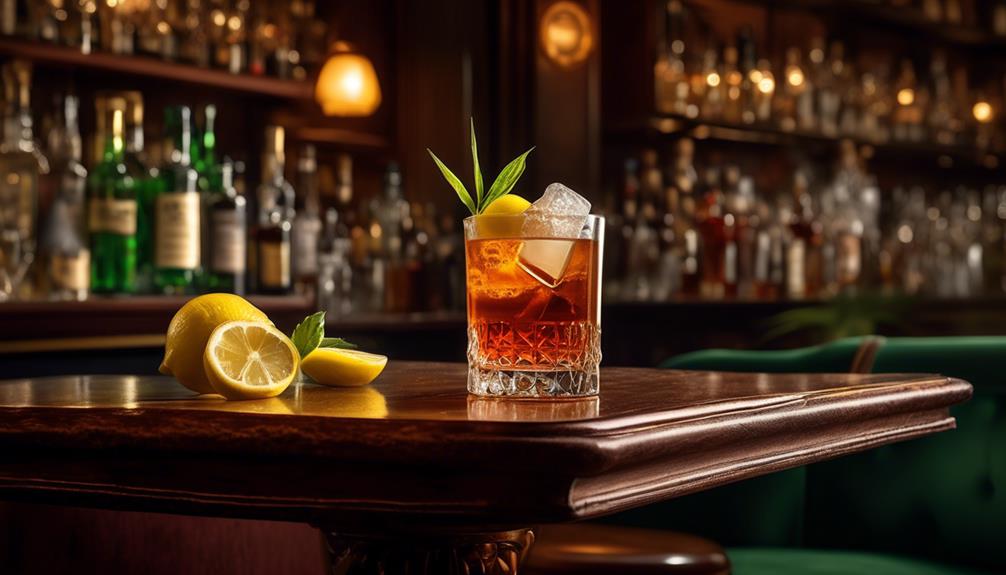
We're about to uncover the essential components that make the Sazerac a beloved classic.
From the unique blend of rye whiskey to the aromatic touch of Peychaud's bitters, each ingredient contributes to the storied allure of this iconic cocktail.
As we explore the historical significance and the traditional preparation process, we'll gain a deeper appreciation for the timeless appeal of the Sazerac.
Key Ingredients Overview
The Sazerac, a famous drink in New Orleans, is crafted using a distinctive combination of ingredients that includes rye whiskey, absinthe, Peychaud's bitters, and a sugar cube. The rye whiskey provides a robust and spicy flavor, while the absinthe adds a subtle anise aroma and a hint of herbal complexity. Peychaud's bitters contribute a unique flavor profile with floral and slightly sweet notes, and the sugar cube balances out the drink with a touch of sweetness. This classic cocktail is known for its rich history and complex taste, making it a beloved choice among cocktail enthusiasts. Below is a table summarizing the key ingredients of the Sazerac:
| Ingredient | Flavor Profile |
|---|---|
| Rye Whiskey | Robust and spicy |
| Absinthe | Subtle anise and herbal |
| Peychaud's Bitters | Floral and slightly sweet |
Preparation Process
Crafting the iconic Sazerac involves a meticulous and time-honored process that showcases the rich history and complexity of its key ingredients.
The preparation process begins by chilling an old-fashioned glass as we meticulously measure and pour absinthe into it, swirling it to coat the glass, and then discarding the excess.
In a separate mixing glass, we gently muddle a sugar cube with a few dashes of Peychaud's Bitters. Next, we add rye whiskey and ice, stirring until well-chilled.
The absinthe-coated glass is then used to strain the whiskey mixture, creating a perfect balance of flavors.
Classic recipe variations may include using different types of bitters or experimenting with alternative spirits, but the essence of the Sazerac lies in the careful execution of its time-honored preparation process.
Historical Significance
Historically, the development of the Sazerac's key ingredients intertwines with the cultural evolution of New Orleans, reflecting the city's vibrant and dynamic culinary heritage. The Sazerac, considered the oldest known American cocktail, boasts historical significance and cultural impact. Its key ingredients have deep roots in the city's history, with each component contributing to the drink's unique flavor profile. Below is a table outlining the historical significance of the key ingredients:
| Key Ingredient | Historical Significance |
|---|---|
| Sazerac Rye Whiskey | Imported by French Creoles, it became a staple in New Orleans' bars and is integral to the Sazerac's identity. |
| Peychaud's Bitters | Created by Antoine Amedie Peychaud in the early 19th century, it adds a distinctive flavor and is synonymous with New Orleans' cocktail culture. |
| Absinthe | Popular in the 19th century, it was later banned but eventually reinstated, playing a crucial role in the Sazerac's evolution. |
These ingredients not only contribute to the Sazerac's exquisite taste but also serve as a testament to New Orleans' rich history.
Crafting the Perfect Sazerac
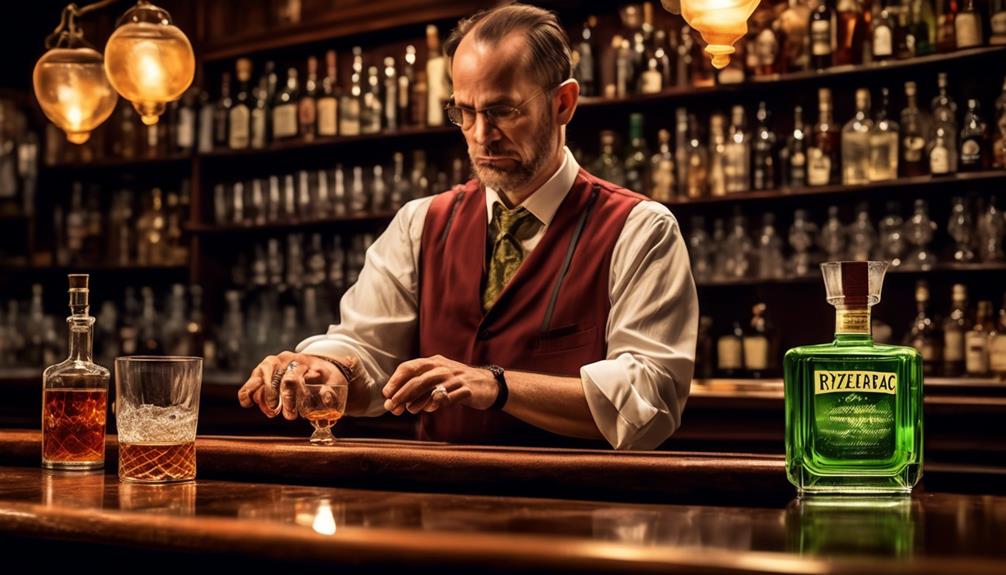
First, let's talk about the key points when it comes to crafting the perfect Sazerac. The ingredients are crucial – the combination of rye whiskey, absinthe, Peychaud's Bitters, and a sugar cube is what gives the Sazerac its unique flavor.
Then, there's the traditional preparation steps that have been followed for generations, each one contributing to the drink's rich history.
And finally, we can't overlook the historical significance of the Sazerac, as it's not just a cocktail, but a symbol of New Orleans' cocktail culture and heritage.
Sazerac Ingredients
The Sazerac, a quintessential cocktail of New Orleans, requires a careful selection of ingredients to achieve its historical and authentic flavor profile. To craft the perfect Sazerac, one must consider the following essential components:
- Rye Whiskey: The backbone of the Sazerac, rye whiskey provides the robust and spicy flavor essential to this iconic cocktail.
- Absinthe: A touch of absinthe adds a distinct anise flavor, enhancing the complexity of the Sazerac's taste.
- Sugar Cube: The sweetness of a sugar cube balances the drink's bold flavors, creating a harmonious blend on the palate.
- Peychaud's Bitters: This unique blend of botanicals and gentian lends the Sazerac its signature aromatic and tangy undertones.
Each ingredient plays a crucial role in honoring the rich history and flavor profile of the Sazerac, ensuring an unparalleled drinking experience.
Traditional Preparation Steps
Crafting a perfect Sazerac involves a meticulous and time-honored process that captures the essence of New Orleans' rich cocktail tradition. The traditional techniques used in preparing this iconic drink have been passed down through generations, ensuring that each sip tells a story of the city's history. Here is a glimpse into the traditional preparation steps for a classic Sazerac, along with some modern twists to consider:
| Traditional Techniques | Modern Twists |
|---|---|
| 1. Chill an old-fashioned glass by placing it in the freezer. | 1. Use smoked glassware for an added depth of flavor. |
| 2. In a separate mixing glass, muddle a sugar cube with a few dashes of Peychaud's Bitters. | 2. Experiment with different types of bitters for unique flavor profiles. |
| 3. Add rye whiskey to the mixing glass and fill it with ice. Stir until well-chilled. | 3. Consider using other spirits like cognac for a twist on the classic recipe. |
| 4. Discard the ice from the chilled glass and coat the inside with absinthe, then pour the whiskey mixture into the glass. | 4. Garnish with a lemon twist or a few drops of aromatic bitters for an elevated presentation. |
These steps, rooted in tradition, lay the foundation for the perfect Sazerac, while modern twists offer an opportunity to personalize this timeless cocktail.
Sazerac's Historical Significance
Sazerac's historical significance can be traced back to the early 19th century when it emerged as a defining emblem of New Orleans' cocktail culture. Its historical origins are rooted in the hands of Antoine Peychaud who crafted the first Sazerac in the 1830s, using his eponymous bitters.
This iconic libation has witnessed the evolution of New Orleans' cultural impact, becoming a symbol of the city's rich history and heritage.
The Sazerac's historical significance is also deeply intertwined with the Prohibition era, as it managed to endure and retain its popularity despite the challenging times.
Its enduring legacy is a testament to its cultural impact, as it continues to be celebrated and enjoyed by locals and visitors alike, cementing its status as a timeless classic in the world of mixology.
Sazerac's Evolution Over Time
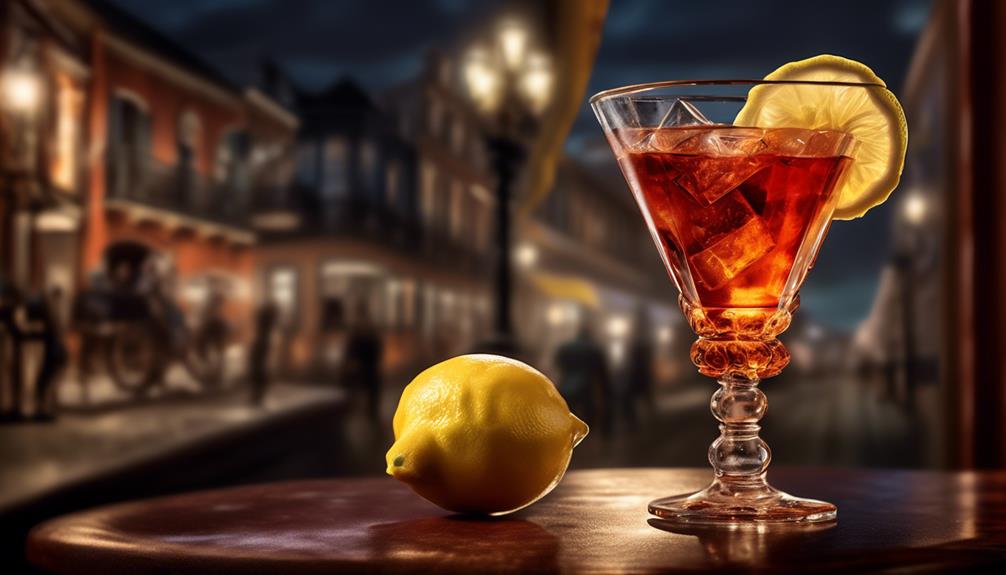
Evolving from its humble beginnings in the early 19th century, the Sazerac has undergone significant changes in its recipe and popularity over time. As the Sazerac evolved, it underwent modernization, leading to variations in its recipe and a notable cultural impact. The table below highlights the evolution of this iconic cocktail.
| Period | Evolution | Cultural Impact | Recipe Variations |
|---|---|---|---|
| Early 1800s | Sazerac emerges as a medicinal tonic | Influence on New Orleans' social scene | Brandy, not whiskey, as the base |
| Late 1800s | Absinthe replaces traditional bitters | Integration into American cocktail culture | Absinthe rinse, not muddled |
| 20th Century | Rye whiskey becomes the standard base | Symbol of New Orleans' mixology heritage | Lemon twist replaces lemon peel |
| Present Day | Craft cocktail movement influences | Global recognition of New Orleans' cocktail | Custom twists with various bitters |
The Sazerac's evolution reflects the dynamic nature of mixology and the cultural significance of this iconic New Orleans drink. Its enduring appeal lies in its ability to adapt to changing tastes while retaining its historical roots.
Iconic Bars Serving the Sazerac
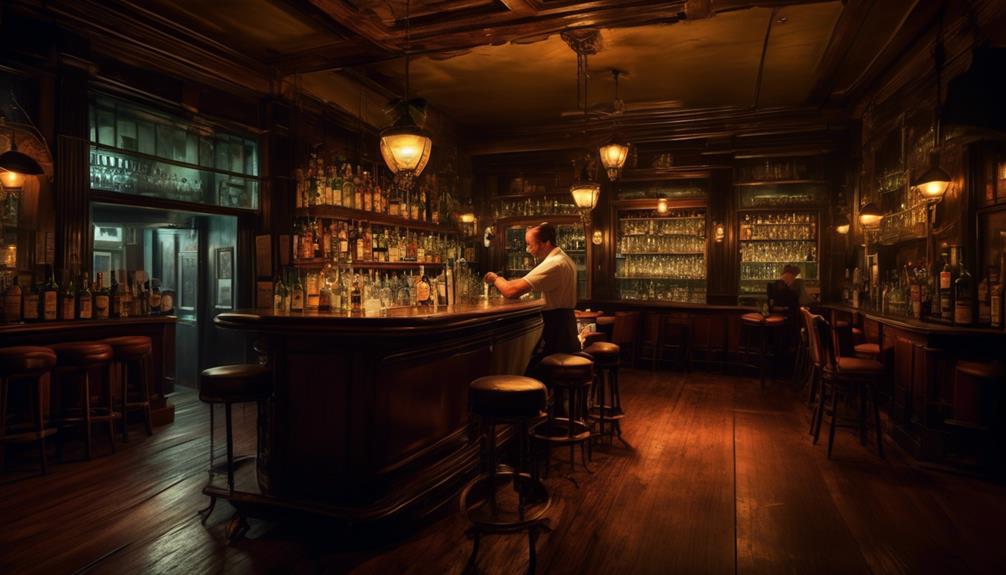
When it comes to iconic bars serving the Sazerac in New Orleans, the variations in the recipe and the historical significance of each establishment are worth exploring.
We'll take you on a journey through the unique ways in which the Sazerac is crafted at these iconic bars, and delve into the historical roots that make each one a vital part of the city's cocktail culture.
Join us as we uncover the flavors and stories that have made these bars legendary in the world of mixology.
Sazerac Recipe Variations
In the heart of New Orleans, iconic bars serve their own unique variations of the classic Sazerac cocktail, each paying homage to the rich historical roots of this renowned drink. These modern twists on the traditional Sazerac recipe showcase the creativity and innovation of mixologists, while still honoring the cocktail's storied past.
Here are some of the most notable Sazerac variations found in iconic bars throughout New Orleans:
- The Refined Rye: Infusing the Sazerac with a higher rye content for a spicier profile, creating a bolder and more robust flavor.
- Citrus Burst: Adding a twist of fresh citrus or a splash of orange liqueur, imparting a zesty and refreshing element to the cocktail.
- Herbal Infusion: Incorporating herbal or floral notes through the use of unique bitters or herbal liqueurs, elevating the Sazerac with a nuanced complexity.
- Smoked Sensation: Infusing the cocktail with a hint of smokiness, achieved through the use of smoked bitters or a brief exposure to wood smoke, adding depth and intrigue to the drink.
Historical Significance
After exploring the modern twists on the traditional Sazerac recipe, we delve into the historical significance of iconic bars serving this renowned cocktail in New Orleans.
The Sazerac, with its deep historical origins, has become a cultural symbol of the city. Iconic bars such as the Sazerac Bar at The Roosevelt Hotel and the historic Napoleon House have played pivotal roles in shaping the cocktail's cultural impact.
The Sazerac Bar, dating back to 1938, exudes the old-world charm of New Orleans, providing a nostalgic setting to savor this classic libation.
Meanwhile, the Napoleon House, a 200-year-old landmark, has become synonymous with the Sazerac, drawing patrons seeking a taste of history.
These iconic bars not only serve the Sazerac but also preserve the rich historical legacy of this quintessential New Orleans cocktail.
Sazerac's Influence on New Orleans
With its roots in the 19th century, the Sazerac cocktail has left an indelible mark on the cultural and social landscape of New Orleans. This iconic libation has greatly influenced the city in numerous ways, embedding itself deeply within the fabric of New Orleans' history and traditions.
- Historical Influence: The Sazerac's popularity has been instrumental in shaping New Orleans' reputation as a hub for mixology and cocktail culture, drawing in aficionados and tourists alike to experience its rich and storied heritage.
- Cultural Symbolism: The Sazerac has become a symbol of New Orleans' resilience, having evolved and persevered through Prohibition, the Civil War, and various societal shifts, reflecting the city's ability to adapt while holding on to its roots.
- Social Rituals: Its influence extends beyond the bar, seeping into social rituals and gatherings, where its presence signifies conviviality and camaraderie, becoming a staple in celebrations and gatherings across the city.
- Economic Impact: The Sazerac's evolution and influence have also significantly impacted the economic landscape of New Orleans, contributing to the city's thriving hospitality and tourism industries, further solidifying its position as a cultural and culinary destination.
Sazerac and New Orleans Culture

Embedded within the vibrant tapestry of New Orleans culture, the Sazerac cocktail stands as a timeless emblem of tradition and conviviality, reflecting the city's rich and enduring heritage. New Orleans' cocktail culture is deeply intertwined with the Sazerac, which has been an integral part of local traditions for over a century. This iconic libation isn't just a drink; it's a story in a glass, a blend of history and taste that has evolved alongside the city itself.
The Sazerac's journey mirrors the mixology evolution in New Orleans, adapting to the changing times while preserving its essence. Local traditions have imbued the Sazerac with a distinct sense of identity, making it a symbol of the city's spirit. The influence of bourbon, a key ingredient in the Sazerac, further underscores its connection to New Orleans. The warm, oaky notes of bourbon infuse the cocktail with a touch of Southern charm, echoing the city's hospitality and allure.
As we savor a Sazerac in New Orleans, we don't just taste a drink; we taste the soul of a city that has mastered the art of blending history, culture, and mixology into a single, unforgettable experience.
Sazerac's Popularity Beyond New Orleans
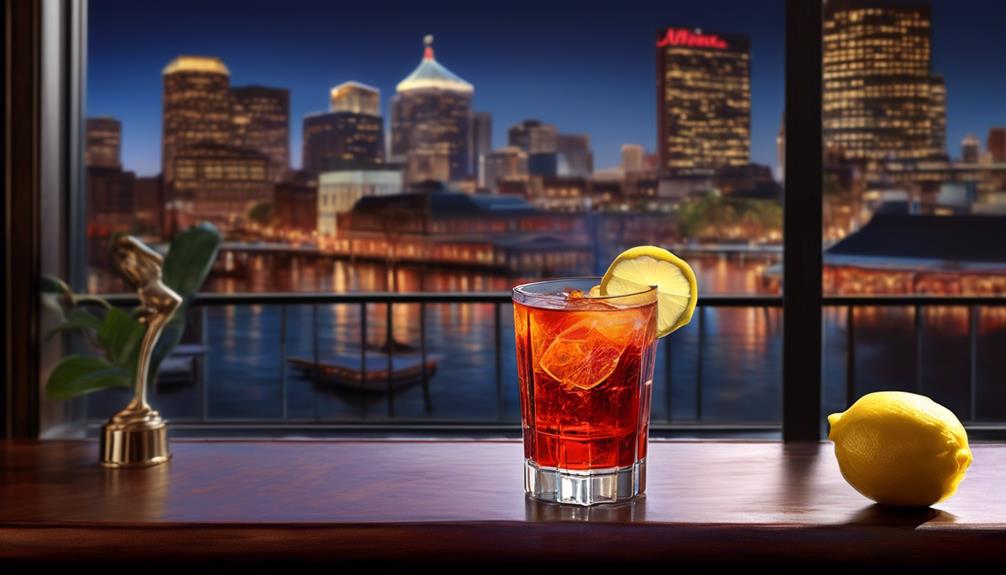
Beyond the storied streets of New Orleans, the Sazerac has found its place as a beloved cocktail, captivating palates across the country with its timeless allure and historic significance. Its global appeal and cultural impact have solidified its status as a symbol of American cocktail heritage.
- Craft Cocktail Renaissance: The Sazerac's popularity has surged as part of the craft cocktail renaissance, drawing attention to its unique blend of flavors and historical roots.
- Bar Menus Everywhere: From upscale lounges to neighborhood bars, the Sazerac has become a staple on drink menus nationwide, showcasing its widespread influence.
- Cultural Icon: Recognized not only for its taste but also for its cultural impact, the Sazerac has become a representation of New Orleans' rich history and the broader American cocktail tradition.
- Global Recognition: With its presence in international cocktail competitions and its inclusion in renowned bartending guides, the Sazerac has garnered global recognition, further cementing its status as a timeless classic.
As the Sazerac continues to be embraced by cocktail enthusiasts and mixologists worldwide, its enduring legacy and cultural significance are sure to endure for generations to come.
Variations of the Classic Sazerac
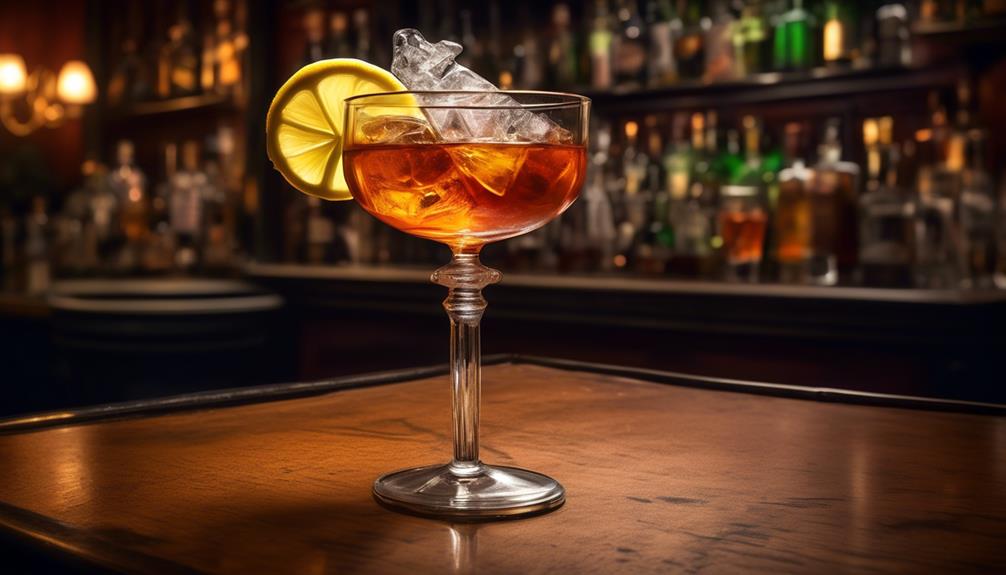
In the realm of cocktail culture, the classic Sazerac has inspired a myriad of variations that pay homage to its rich history and distinctive flavor profile. From the traditional recipe, which calls for rye whiskey, absinthe, Peychaud's bitters, and a sugar cube, to modern twists that incorporate innovative ingredients, the Sazerac has evolved while maintaining its timeless allure.
One popular variation is the addition of different types of bitters, such as Angostura or orange bitters, which offer a new depth of flavor to the cocktail. Some mixologists also experiment with alternative spirits like bourbon or brandy, resulting in unique interpretations that captivate the palate.
Furthermore, the modern cocktail scene has seen Sazerac variations that include creative infusions, flavored syrups, and garnishes that add a contemporary flair to the drink. Whether it's a smoked glass, a citrus twist, or a flavored sugar rim, these innovative touches elevate the Sazerac experience while staying true to its historical roots.
Exploring these diverse Sazerac variations allows enthusiasts to appreciate the cocktail's adaptability and time-honored appeal, making each sip a journey through tradition and innovation.
The Sazerac Experience in New Orleans
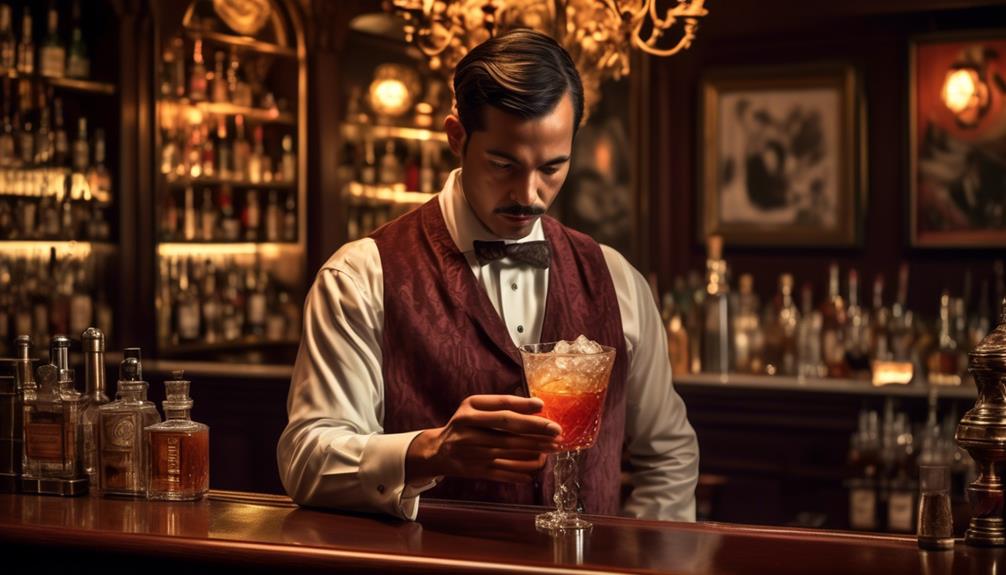
When it comes to experiencing the Sazerac in New Orleans, one can't help but be immersed in the rich historical heritage and authentic ambiance of this iconic cocktail. The Sazerac, often hailed as the oldest known American cocktail, has a history as captivating as the city it hails from.
Here's what makes the Sazerac experience in New Orleans truly exceptional:
- Sazerac History: Immerse yourself in the legacy of the Sazerac at historic bars such as the Napoleon House or Antoine's Annex, where the cocktail's origins are as much a part of the experience as the drink itself.
- Cocktail Culture: Engage with the passionate bartenders who've perfected the art of crafting the perfect Sazerac, and learn about the traditions and techniques that have been passed down through generations.
- Historical Ambiance: Step into the hallowed halls of centuries-old establishments, where the walls seem to whisper tales of bygone eras, and savor the Sazerac amidst the timeless charm of New Orleans.
- Authenticity: From the meticulously selected rye whiskey to the genuine absinthe rinse, every element of the Sazerac experience in New Orleans is steeped in authenticity, offering a taste of tradition that transcends time.
Frequently Asked Questions
What Are Some Other Popular Drinks in New Orleans Besides the Sazerac?
In New Orleans, cocktail culture runs deep, with craft cocktails and mixology taking center stage. Beyond the iconic Sazerac, popular drinks include the refreshing Ramos Gin Fizz, the vibrant Hurricane, and the unique Vieux Carré.
These libations showcase the city's rich history and embrace unique ingredients, making each sip a journey through New Orleans' spirited past.
Are There Any Famous Celebrities or Historical Figures Associated With the Sazerac?
Are there any famous figures associated with the Sazerac?
Absolutely! This trademark cocktail has deep historical roots, with notable fans such as Mark Twain and Frank Sinatra. Its cultural impact is undeniable, and its popularity continues to soar.
The Sazerac's rich history and iconic status have solidified it as a beloved fixture in New Orleans and beyond. Its influence extends far and wide, making it one of the most celebrated beverages in the world.
How Has the Sazerac Affected the Local Economy in New Orleans?
The sazerac has had a significant impact on the local economy in New Orleans. Its historical significance and unique taste have made it a staple of the city's culture, attracting tourists and boosting the local economy.
The demand for sazeracs has also spurred the growth of local distilleries, creating jobs and supporting the economy. This iconic drink has become a symbol of New Orleans, drawing visitors and contributing to the city's vibrant and thriving hospitality industry.
Are There Any Health Benefits or Drawbacks Associated With Drinking a Sazerac?
Drinking a Sazerac, with its rich history and cultural significance, has both benefits and drawbacks.
While the alcohol content should be consumed responsibly, the mixology techniques and local ingredients can offer a unique experience. The historical origins and traditional preparation techniques add to its allure. Additionally, cocktail variations provide a range of flavors.
However, moderation is crucial due to the alcohol content.
What Are Some Common Misconceptions About the Sazerac?
Common misconceptions about the Sazerac often revolve around its historical origins and traditional recipe. Many believe it to be a classic cocktail, but its modern variations have evolved over time.
Some may think it's always made with rye whiskey, when in fact, it originally featured cognac.
Understanding the drink's adaptation and variations can enhance appreciation for its rich history and diverse flavors.
Conclusion
In conclusion, the Sazerac has stood the test of time as the most famous drink in New Orleans. Its roots date back to the 19th century, and its unique blend of rye whiskey, absinthe, and bitters continues to captivate locals and visitors alike.
As the sun sets over the city, the sound of jazz fills the air, and a perfectly crafted Sazerac in hand transports you back to the golden age of New Orleans. It's a taste of history in every sip.
- About the Author
- Latest Posts
Introducing Ron, the home decor aficionado at ByRetreat, whose passion for creating beautiful and inviting spaces is at the heart of his work. With his deep knowledge of home decor and his innate sense of style, Ron brings a wealth of expertise and a keen eye for detail to the ByRetreat team.
Ron’s love for home decor goes beyond aesthetics; he understands that our surroundings play a significant role in our overall well-being and productivity. With this in mind, Ron is dedicated to transforming remote workspaces into havens of comfort, functionality, and beauty.
Mardi Gras Decoration
Mardi Gras Decor Ideas: Bringing New Orleans Flair to Your Home
Get inspired with vibrant Mardi Gras decor ideas to transform your home into a festive New Orleans celebration that your guests won’t forget!
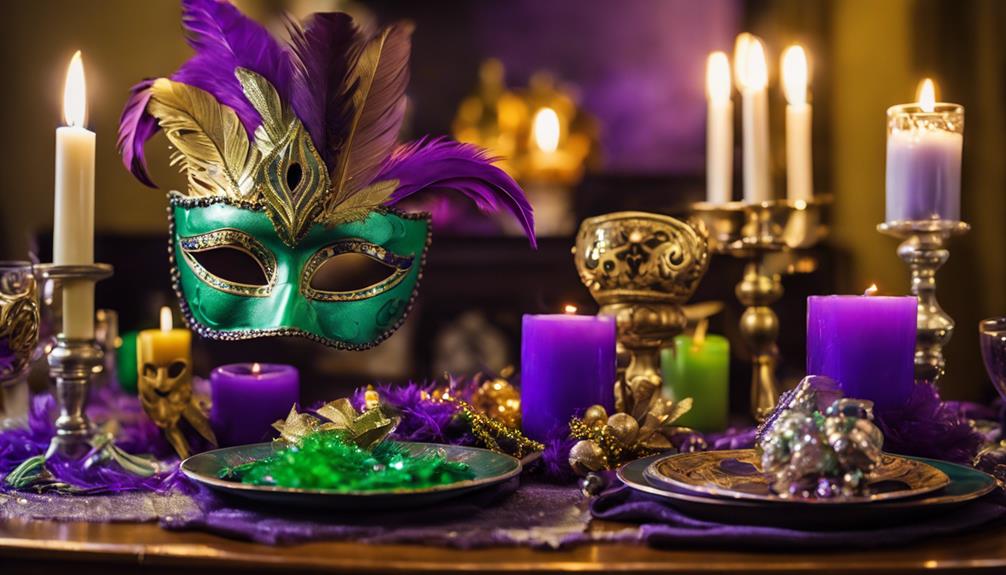
To bring the vibrant flair of New Orleans Mardi Gras into your home, embrace bold colors like purple, green, and gold. Add festive elements like masks, beads, and king cake to create an authentic atmosphere. Use a crisp white tablecloth to highlight colorful dishes and DIY decorations, like painted glassware or custom banners. Engage your guests with a themed coffee bar and vibrant centerpieces. Don't forget to design your space for conversation and fun. With these ideas, your Mardi Gras celebration will be unforgettable. Explore more creative tips to enhance your festive ambiance further!
Key Takeaways
- Embrace bold colors like purple, green, and gold to capture the essence of Mardi Gras and create a festive atmosphere.
- Incorporate traditional elements such as masks, beads, and king cake to enhance authenticity and celebrate New Orleans culture.
- Use a crisp white tablecloth as a backdrop to make vibrant decorations pop for an eye-catching table setting.
- Engage in DIY projects, like painting glassware and creating bead curtains, to add a personal touch to your decor.
Celebrate With Bold Colors
To truly celebrate Mardi Gras, you should embrace bold colors like purple, green, and gold, which capture the essence of this vibrant festival.
These bright colors not only symbolize justice, faith, and power, but they also bring an energetic flair to your home. Start with simple decorating ideas that incorporate these hues in your interior design. You might love to see table settings adorned with vibrant napkins and centerpieces that reflect the spirit of Mardi Gras.
Consider DIY projects that are budget friendly, like painting glassware in these festive colors or creating custom banners.
Adding colorful masks and beads as decorative accents can also enhance the festive theme, evoking the excitement of Mardi Gras parades right in your living space.
Don't overlook the power of floral arrangements; choose seasonal blooms in bold hues to serve as focal points in your home.
With these decorating ideas, you'll create a lively atmosphere that truly celebrates the spirit of Mardi Gras, inviting friends and family to join in the fun.
Essential Mardi Gras Elements

What essential elements should you include to create an authentic Mardi Gras celebration?
Start with a crisp white tablecloth as your base to enhance the vibrant colors of your decor. Incorporate classic Mardi Gras elements like king cake, masks, and beads, which capture the spirit of this festive occasion. Use simple white dishes for versatility and consider personalizing them with DIY plate decorations using glass paint markers.
To elevate your dining experience, add vintage candleholders and colorful drip candles, creating a warm and inviting ambiance. Gold napkins paired with Mardi Gras beads as decorative napkin rings will bring a touch of elegance to your table setting.
Don't forget about the festive beverages! Serve kids Abita Root Beer while adults can enjoy traditional offerings like Café Du Monde coffee and beignets.
These essential components won't only enhance the overall look of your Mardi Gras celebration but also immerse your guests in the rich cultural heritage of New Orleans. By including these elements, you'll create a lively atmosphere that captures the joy and excitement of Mardi Gras.
DIY Decor Projects

Enhancing your Mardi Gras celebration can be as simple as incorporating fun DIY decor projects that reflect the festive spirit of the occasion. These projects not only add a vibrant touch to your home but also create a warm and inviting atmosphere for your guests.
Here are some easy DIY decor ideas to get you started:
- Festive Bead Curtains: Create a curtain using strands of beads from Dollar Tree for just $3. This eye-catching display works great for entryways or windows.
- Themed Coffee Bar Sign: Paint a six-inch canvas with fun designs and add voodoo doll stitches for a unique sign that brings a playful touch to your coffee bar.
Tips for Hosting Parties
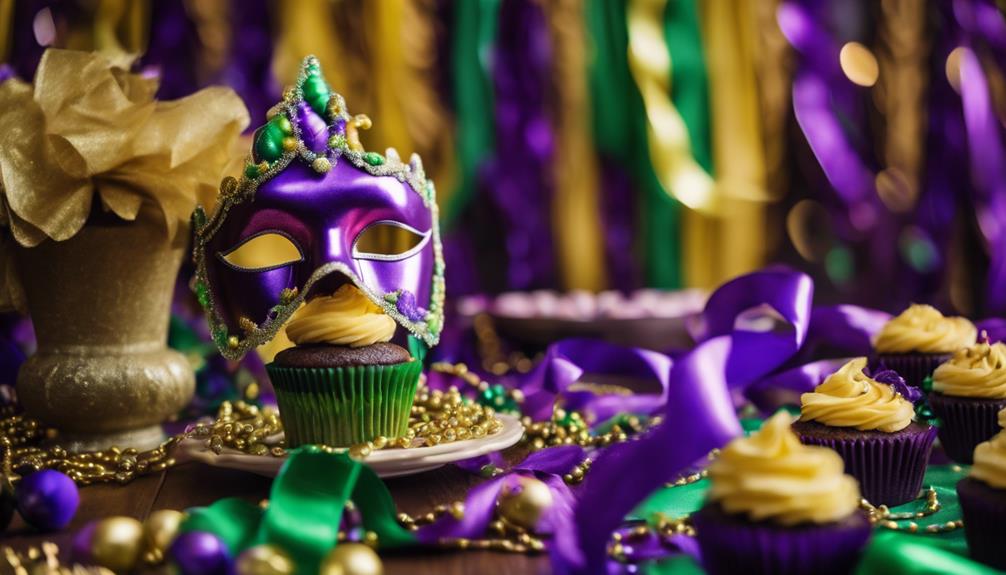
Hosting a memorable Mardi Gras party starts with a thoughtful layout that encourages conversation and keeps guests engaged. Assess your space and arrange furniture to create a welcoming atmosphere. Consider how guests will flow through the area, ensuring accessibility while mingling.
Use bold colors and festive decorations, like masks and beads, to enhance the celebratory spirit of your gathering. Think about incorporating multifunctional spaces—set up areas for dining, socializing, and entertainment. This allows guests to enjoy varied activities throughout the party.
To achieve cohesive decor, utilize themed elements such as a king cake centerpiece and vintage candleholders adorned with colorful candles. These details tie the room together and create a festive vibe.
As you're hosting parties, take note of how guests interact with your space. This can reveal areas for improvement, helping you make adjustments for future gatherings.
Incorporating Personal Style

Personalizing your Mardi Gras decor not only reflects your unique style but also makes your celebration feel more intimate and special. By showcasing unique treasures, like heirlooms and colorful pieces, you can weave your history into the festivities. Embrace bold colors—purple, green, and gold—to create lively spaces that resonate with your love for the holiday.
Here are some ideas to incorporate your personal taste:
- Use simple white dishes as a versatile base, allowing you to customize with themed elements like masks and beads.
- Engage in DIY projects such as painting personalized plates or crafting themed signs to add character and authenticity to your decor.
Frequently Asked Questions
When Should I Start Decorating for Mardi Gras?
You should start decorating for Mardi Gras at least a week before the event. This way, you'll have plenty of time to gather supplies and create vibrant displays that capture the festive spirit.
How Do You Have a Mardi Gras Party at Home?
To host a Mardi Gras party at home, you'll need vibrant colors, festive foods, lively music, and engaging activities. Set the scene, serve traditional dishes, and encourage creativity to create an unforgettable celebration.
How Do You Decorate for Mardi Gras?
To decorate for Mardi Gras, use vibrant colors like purple, green, and gold. Incorporate masks, beads, and themed vignettes. Consider DIY projects to personalize your space, adding vintage candleholders for an elegant, festive touch.
Conclusion
As you deck your home in vibrant purples, greens, and golds, it's funny how a celebration rooted in joy can remind you of life's chaos.
You might think you're just hanging beads and masks, but in reality, you're weaving a tapestry of memories, laughter, and community.
So, whether you're hosting a grand party or enjoying a quiet moment, remember: it's the spirit of Mardi Gras that transforms your space, turning your home into a joyous escape.
- About the Author
- Latest Posts
Introducing Ron, the home decor aficionado at ByRetreat, whose passion for creating beautiful and inviting spaces is at the heart of his work. With his deep knowledge of home decor and his innate sense of style, Ron brings a wealth of expertise and a keen eye for detail to the ByRetreat team.
Ron’s love for home decor goes beyond aesthetics; he understands that our surroundings play a significant role in our overall well-being and productivity. With this in mind, Ron is dedicated to transforming remote workspaces into havens of comfort, functionality, and beauty.
Mardi Gras Decoration
Why Is Mardi Gras a Religious Holiday

Some people may argue that Mardi Gras is just a festival of partying and extravagance, completely disconnected from any religious meaning. Nevertheless, when delving into the historical origins and cultural customs of this yearly event, it becomes clear that Mardi Gras has strong ties to religious symbolism and practices.
From its origins as a Christian feast day to its connections with the Lenten season and spiritual practices, Mardi Gras holds a significant religious significance. But how exactly did this festive event become associated with religious observances?
Stay tuned as we uncover the religious underpinnings of Mardi Gras and its relevance in modern-day celebrations.
Key Takeaways
- Mardi Gras has pagan roots and was incorporated into the Christian liturgical calendar.
- The colors of Mardi Gras (purple, green, and gold) have Christian symbolism.
- Mardi Gras marks the beginning of the Christian liturgical season of fasting and reflection.
- Masks, throws, and king cakes all have religious symbolism in Mardi Gras celebrations.
Origins of Mardi Gras
The origins of Mardi Gras date back to ancient pagan celebrations and were later incorporated into Christian traditions. Mardi Gras, French for 'Fat Tuesday,' has deep pagan roots, originally linked to Roman and Greek festivals celebrating the arrival of spring and fertility. These pagan festivities were eventually adapted by the Christian church as a way to incorporate and reframe these cultural celebrations within the context of Christian beliefs.
Over time, the carnival-like atmosphere and traditions of Mardi Gras became intertwined with the Christian liturgical calendar, specifically the period of feasting and celebration before the solemnity of Lent.
The cultural significance of Mardi Gras lies in its ability to bring people together in joyous celebration before the introspective and penitent season of Lent. It has become a time for communities to come together, feast, and revel in the richness of life before a period of sacrifice and reflection. This celebration reflects the deep human need for both communal joy and personal growth, making Mardi Gras a holiday with profound spiritual and cultural significance.
Christian Traditions and Symbolism

Christian traditions and symbolism play a significant role in the evolution and observance of Mardi Gras. The colors of Mardi Gras, purple, green, and gold, are steeped in Christian symbolism. Purple symbolizes justice, green represents faith, and gold signifies power. These colors reflect the religious significance of Mardi Gras, reminding us of our Christian values and calling us to live out these virtues.
The practice of consuming rich and indulgent foods before the fasting period of Lent also holds religious connotations. This tradition, known as 'Fat Tuesday,' encourages us to reflect on the upcoming period of self-discipline and spiritual growth. It serves as a reminder of Christ's sacrifice and the importance of repentance and inner renewal.
Furthermore, Mardi Gras is deeply tied to Christian traditions through its association with the liturgical calendar. The observance of Ash Wednesday, which marks the beginning of Lent, is intrinsically linked to the revelry of Mardi Gras. This juxtaposition of celebration and solemnity underscores the profound religious significance of Mardi Gras within the Christian faith.
Relationship With the Lenten Season
As believers, we closely connect Mardi Gras with the upcoming Lenten season, a period of reflection and spiritual growth. Mardi Gras, also known as Fat Tuesday, falls just before Ash Wednesday, which marks the beginning of Lent. This connection is deeply rooted in Catholic tradition, where Mardi Gras serves as a final celebration before the solemn and reflective season of Lent. It's a time for us to prepare our hearts and minds for the Lenten journey ahead, where we focus on prayer, fasting, and almsgiving.
Lenten preparation starts with the joyous festivities of Mardi Gras, reminding us of the upcoming season's call to serve others with humility and compassion. As we engage in the revelry of Mardi Gras, we're also mindful of the need to embark on a period of self-examination and spiritual discipline during Lent. This dual experience reinforces the connection between the two, reminding us of the importance of balancing celebration with introspection and service.
Our relationship with the Lenten season isn't just about personal reflection but also about how we can better serve those around us. This connection between Mardi Gras and Lent deepens our understanding of the call to love and serve others, making the transition from celebration to spiritual growth seamless and purposeful.
Religious Observances and Practices

In our religious observances and practices, we engage in acts of devotion and service that deepen our spiritual connection and foster a sense of community. These practices are essential for nurturing our faith and strengthening our bond with each other.
Here are some key aspects of our religious observances and practices:
- Prayer Rituals
- We believe in the power of prayer to seek guidance, express gratitude, and offer intercession for others.
- Through regular prayer rituals, we cultivate a deeper connection with the divine and find solace in times of need.
- Service to Others
- Serving others is integral to our religious beliefs, and we actively seek opportunities to extend compassion and support to those in need.
- By engaging in acts of service, we emulate the values of our faith and contribute to the well-being of our community.
- Religious Festivals
- Religious festivals hold great significance in our spiritual journey, providing opportunities for communal worship, reflection, and celebration.
- These festivals offer a chance for us to come together as a community, reaffirm our shared beliefs, and find inspiration in the collective expression of faith.
Our religious observances and practices are a testament to our commitment to serving others and nurturing our spiritual connection through prayer rituals and participation in religious festivals.
Spiritual Significance in Modern Celebrations
Amidst the vibrant festivities of modern celebrations, we find a deep and enduring spiritual significance that unites us in shared reverence and reflection.
In today's Mardi Gras, the spiritual aspect has evolved to encompass a broader, more inclusive understanding. Modern interpretations of Mardi Gras emphasize the cultural significance of coming together as a community to celebrate life, joy, and resilience.
It's a time when people seek to uplift one another, embodying the values of compassion, kindness, and charity. This spiritual underpinning is evident in the various community service initiatives that have become integral to Mardi Gras celebrations.
From volunteering at local shelters to organizing food drives, there's a growing emphasis on using this festive occasion as an opportunity to serve and support those in need.
In this way, Mardi Gras has become not only a time of revelry but also a period of meaningful connection and service to others, reflecting the enduring spiritual significance that continues to shape modern celebrations.
Frequently Asked Questions
How Do Non-Christian Religions and Cultures Celebrate Mardi Gras?
We celebrate Mardi Gras with non-Christian celebrations and cultural influences. People of various faiths and backgrounds come together to participate in the festivities.
Non-Christian traditions such as parades, mask-wearing, and indulging in rich foods are integrated into the celebrations.
Cultural influences from different regions and ethnicities add vibrant and diverse elements to the Mardi Gras festivities, creating a unique and inclusive experience for everyone involved.
What Is the Role of Mardi Gras in the History of Religious Persecution and Tolerance?
Mardi Gras has a significant role in the history of religious tolerance and has been tied to historical persecution. The celebration represents a time of religious freedom and acceptance, where diverse cultures come together in unity.
The festivities reflect the resilience of communities in the face of religious adversity. Through the ages, Mardi Gras has stood as a symbol of religious tolerance and the triumph of the human spirit over oppression.
How Do Different Christian Denominations Interpret the Religious Significance of Mardi Gras?
Different Christian denominations interpret the religious significance of Mardi Gras differently. These interpretation differences stem from varying theological beliefs and historical traditions.
The religious significance celebrations can range from solemn reflections on the upcoming Lenten season to joyous celebrations of the last moments before the fasting period.
Understanding these differences allows us to appreciate the diverse ways in which different denominations honor this important religious holiday.
Are There Any Specific Prayers or Rituals Associated With Mardi Gras in Religious Observances?
Prayer traditions and ritual practices are integral to religious observances of Mardi Gras. Many denominations hold special prayer services and engage in symbolic rituals as part of their Mardi Gras celebrations. These can include praying for forgiveness, participating in processions, and observing fasting and abstinence.
These practices are intended to prepare for the solemn season of Lent and reflect on the spiritual significance of Mardi Gras.
How Have Modern Interpretations of Spirituality and Mindfulness Influenced the Way Mardi Gras Is Celebrated in Religious Communities?
Modern interpretations of spirituality and secular influence have shaped the way Mardi Gras is celebrated in religious communities.
Spiritual mindfulness has led to a greater emphasis on reflection and serving others during this cultural celebration.
In some religious observances, Mardi Gras has evolved to incorporate elements of community service and outreach, reflecting a deeper connection to the principles of faith and compassion in the modern context.
Conclusion
In conclusion, Mardi Gras is a religious holiday rooted in rich traditions and symbolism. Its origins and observances are deeply tied to the Christian faith, particularly in preparation for the Lenten season.
The spiritual significance of Mardi Gras is still evident in modern celebrations, showcasing the enduring connection between faith and festivity.
So let's remember the religious roots and revel in the spiritual significance of this colorful and vibrant holiday!
- About the Author
- Latest Posts
Introducing Ron, the home decor aficionado at ByRetreat, whose passion for creating beautiful and inviting spaces is at the heart of his work. With his deep knowledge of home decor and his innate sense of style, Ron brings a wealth of expertise and a keen eye for detail to the ByRetreat team.
Ron’s love for home decor goes beyond aesthetics; he understands that our surroundings play a significant role in our overall well-being and productivity. With this in mind, Ron is dedicated to transforming remote workspaces into havens of comfort, functionality, and beauty.
Mardi Gras Decoration
How to Make Mardi Gras Decorations
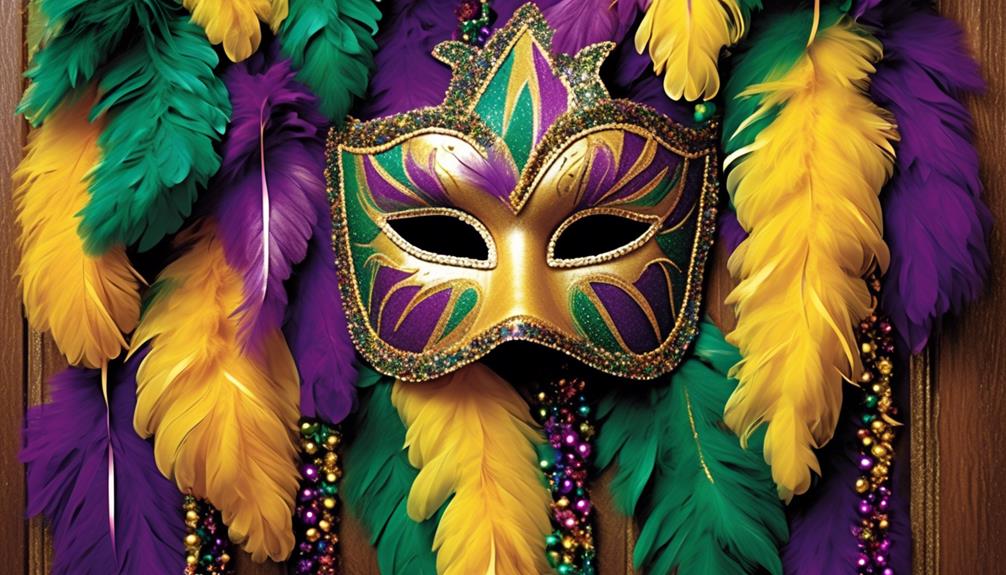
When it comes to decorating for Mardi Gras, we often struggle to find a balance between making a memorable impact and sticking to a budget. The key is to blend boldness and elegance, creating a festive atmosphere that embodies the essence of the holiday without being too overwhelming.
With a few simple yet creative ideas, you can transform any space into a festive Mardi Gras wonderland that will have everyone feeling the festive spirit.
Key Takeaways
- Mardi Gras decorations can include masks, jester hats, bead garlands, feather boas, and glittery table centerpieces.
- Masks can be painted with bold patterns and designs using acrylic paints and glitter.
- Jester hats can be created using colorful cardstock, glitter, bells, and elastic bands.
- Bead garlands can be used to decorate parade floats or create a festive atmosphere, and can also be used to create bead bracelets, necklaces, belts, and headpieces.
Colorful Mardi Gras Masks
Let's get ready to create vibrant and eye-catching Mardi Gras masks that will add a burst of color and excitement to our decorations. Mask painting is a delightful activity that allows us to express our creativity and add a personal touch to the festive ambiance.
To start, gather a variety of plain masks, acrylic paints, paintbrushes, glitter, feathers, and other embellishments. Begin by brainstorming designs and color schemes. Once you have a plan in mind, use the paint to create bold patterns, intricate designs, or even abstract art on the masks. Experiment with different brush strokes and techniques to achieve the desired effect.
Don't forget to let each layer of paint dry before adding new elements to avoid smudging or blending colors unintentionally. As the base design takes shape, explore mask decorating techniques such as adding glitter for a touch of sparkle or attaching feathers to create a dramatic effect.
These masks won't only enhance our decorations but also bring joy to those who see them. Let's share this creative experience with others and spread the vibrant spirit of Mardi Gras!
Festive Bead Garlands
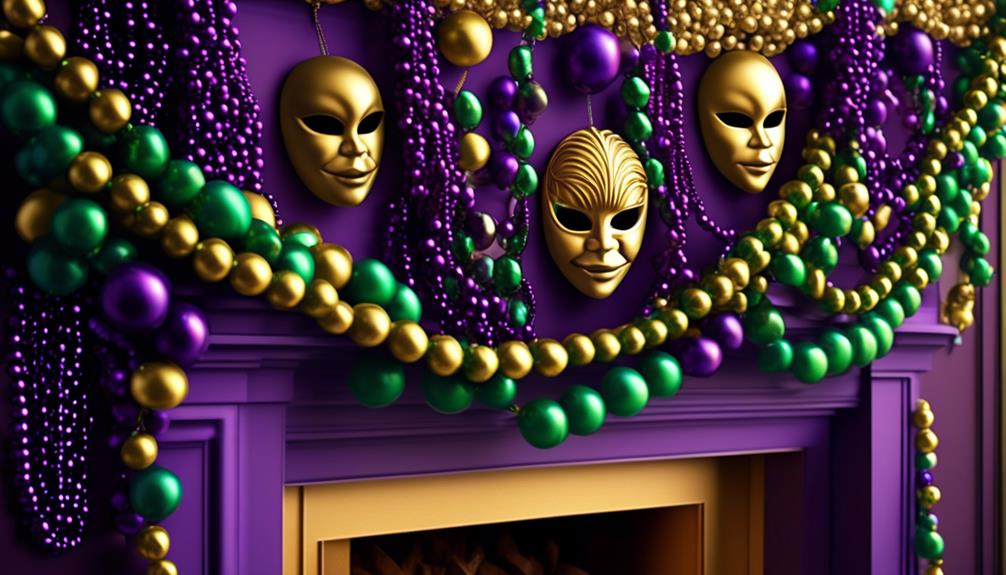
After creating our colorful Mardi Gras masks, we are now ready to dive into the world of festive bead garlands, adding a touch of elegance and flair to our decorations. Bead crafting techniques can elevate the ambiance of any Mardi Gras celebration. To assist you in this endeavor, we've compiled a selection of DIY costume accessories and parade float decorations that will surely delight your guests and spectators.
| Bead Crafting Techniques | Party Favor Ideas | DIY Costume Accessories | Parade Float Decorations |
|---|---|---|---|
| Stringing beads to create stunning garlands | Giving away homemade bead bracelets as party favors | Crafting bead necklaces, belts, and headpieces | Using bead garlands to adorn parade floats and create a festive atmosphere |
Vibrant Feather Boas
Let's talk about the vibrant feather boas!
When it comes to Mardi Gras decorations, feather boas are a must-have.
We'll explore the wide array of feather boa colors, embellishments, and creative hanging ideas to make your Mardi Gras celebration truly unforgettable.
Feather Boa Colors
What are the most vibrant colors available for feather boas to create eye-catching Mardi Gras decorations? When it comes to boa color trends, it's all about bold and lively hues that capture the festive spirit of Mardi Gras.
Here are some vibrant feather boa colors that will make your decorations stand out:
- Emerald Green: This rich and lush shade of green represents the traditional color of Mardi Gras and will instantly bring a touch of elegance to your decor.
- Royal Purple: A deep and regal purple adds a sense of grandeur to your Mardi Gras decorations, symbolizing justice and power.
- Golden Yellow: Bright and radiant, a golden yellow feather boa brings a vibrant burst of energy and joy to your festive arrangements.
These vibrant feather boa colors will elevate your Mardi Gras decorations and create a captivating visual experience for all.
Boa Embellishments
As we explore boa embellishments, we'll incorporate vibrant feather boas, such as emerald green, royal purple, and golden yellow, to infuse our Mardi Gras decorations with elegance and energy.
When creating a boa costume, these feather boas can be draped around hats, sewn onto dresses, or used as sashes for a fun and festive look.
For parade floats, consider using feather boas to adorn the edges, creating a lavish and eye-catching display. To make the most of these boas, intertwine different colors, layer them for a fuller effect, and mix and match textures for added visual appeal.
Additionally, feather boas can be used to create stunning table centerpieces or to embellish masks, adding a touch of glamour to your Mardi Gras celebration.
Boa Hanging Ideas
To create striking boa hanging decorations, select vibrant feather boas in rich colors such as emerald green, royal purple, and golden yellow to infuse your space with the lively spirit of Mardi Gras.
For an eye-catching boa display, consider these hanging arrangements:
- Boa Curtain: Drape long strands of feather boas across doorways or windows to create a dazzling curtain effect, welcoming guests with a festive flair.
- Boa Chandelier: Craft a stunning boa chandelier by suspending multiple boas from a wire frame or hoop, adding a touch of elegance and whimsy to your Mardi Gras festivities.
- Boa Garland: String together colorful feather boas to make a vibrant garland that can be hung along staircases, mantels, or tables, bringing a festive and playful atmosphere to any space.
These hanging arrangements will elevate your Mardi Gras decor and make your celebration truly unforgettable.
Glittery Table Centerpieces
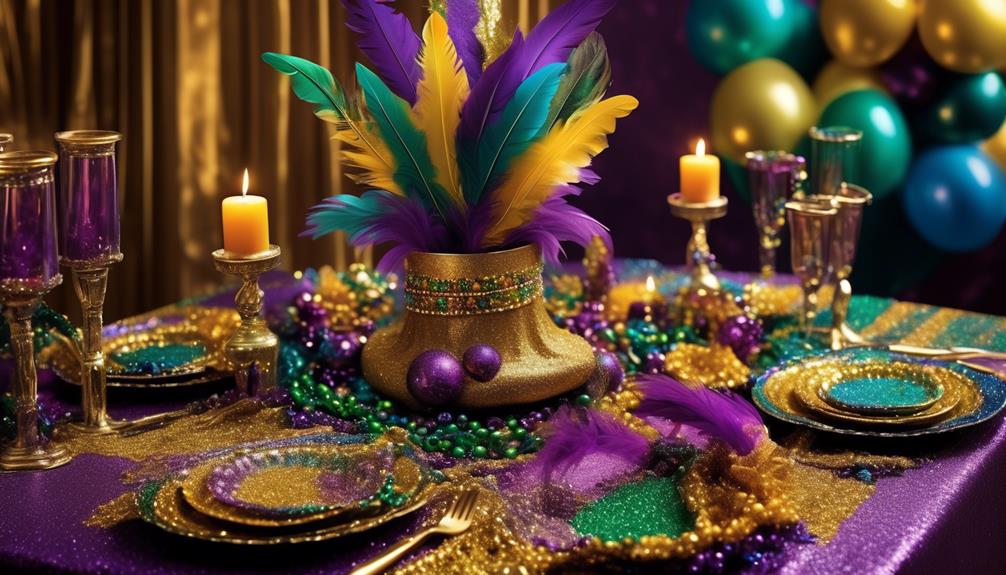
Let's talk about creating stunning glittery table centerpieces for your Mardi Gras celebration.
First, we'll cover the materials needed to bring these dazzling decorations to life.
Then, we'll provide step-by-step assembly instructions to ensure your centerpieces shine bright.
Materials Needed
We can create stunning glittery table centerpieces by gathering clear glass vases, glitter in various colors, mod podge, and paintbrushes for this craft project.
To make these beautiful centerpieces, we can use creative alternatives like recycled glass jars or repurposed wine bottles to serve as the vases. This not only adds a unique touch to the decorations but also provides budget-friendly options.
The glitter in various colors allows for personalization, and the mod podge acts as an adhesive and sealer, ensuring the glitter stays in place.
Paintbrushes are essential for applying the mod podge evenly and precisely onto the vases.
With these materials, we can bring a touch of sparkle and elegance to our Mardi Gras celebration.
Assembly Instructions
Using an assortment of clear glass vases, glitter in various colors, mod podge, and paintbrushes, we can proceed to assemble the glittery table centerpieces for our Mardi Gras celebration.
First, ensure the vases are clean and dry.
Next, apply a coat of mod podge to the outside of the vase using a paintbrush.
Then, sprinkle the glitter onto the mod podge, ensuring it covers the entire surface evenly. For a creative touch, consider mixing different colors of glitter or creating patterns.
Once the glitter is applied, let the vases dry completely.
To prevent the glitter from shedding, seal the glitter with another layer of mod podge.
Allow the vases to dry thoroughly before placing them on the tables.
These centerpieces will surely add a dazzling and festive touch to our Mardi Gras celebration.
Display and Enjoy
With our glittery table centerpieces assembled and dried, we can now showcase them as the sparkling focal point of our Mardi Gras celebration. Here's how to display and enjoy them:
- Place the glittery table centerpieces on the main dining table, ensuring they're evenly spaced to create a stunning visual impact.
- Surround the centerpieces with complementary party supplies such as colorful beads, masks, and feather boas to enhance the festive atmosphere.
- Encourage guests to snap photos with the beautiful DIY crafts and use them as conversation starters, adding an extra touch of charm to the celebration.
Homemade Jester Hats
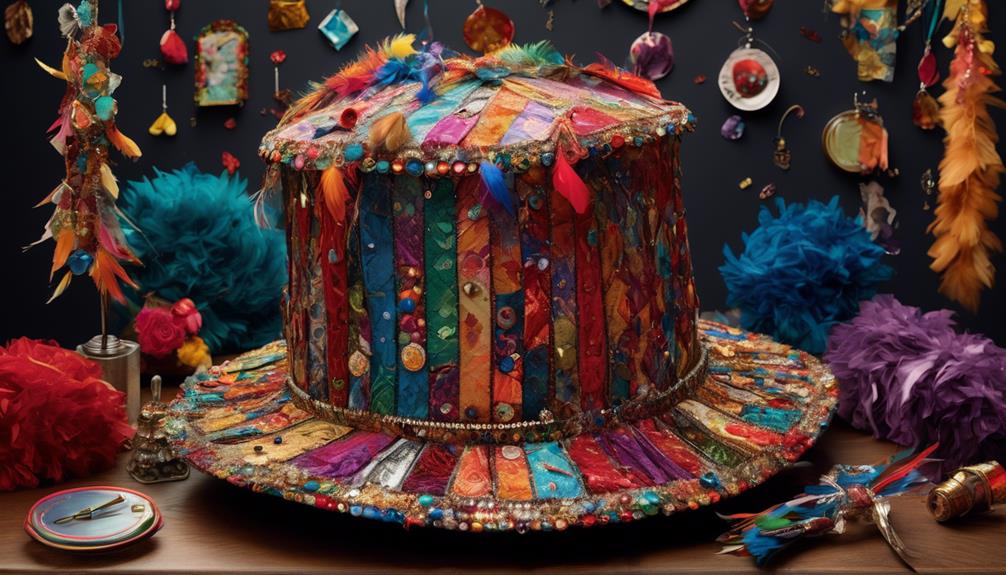
Crafting jester hats at home allows for personalized touches and creativity to shine through, adding a unique and festive flair to your Mardi Gras decorations.
Making DIY costume jester hats can be a fun and rewarding activity for both adults and kids. To start, gather supplies like colorful cardstock, glitter, bells, and elastic bands.
Cut the cardstock into long strips and staple or glue the ends together to form a band that fits around your head. Then, cut out diamond shapes from more cardstock and attach them to the band, alternating colors to create a vibrant, jester-style pattern.
Add glitter and bells for extra pizzazz. For the finishing touch, attach elastic bands to keep the hat in place.
These homemade jester hats can be great additions to your Mardi Gras party favors, and they also provide a delightful activity for guests to engage in during the celebration.
Sparkling Door Wreaths
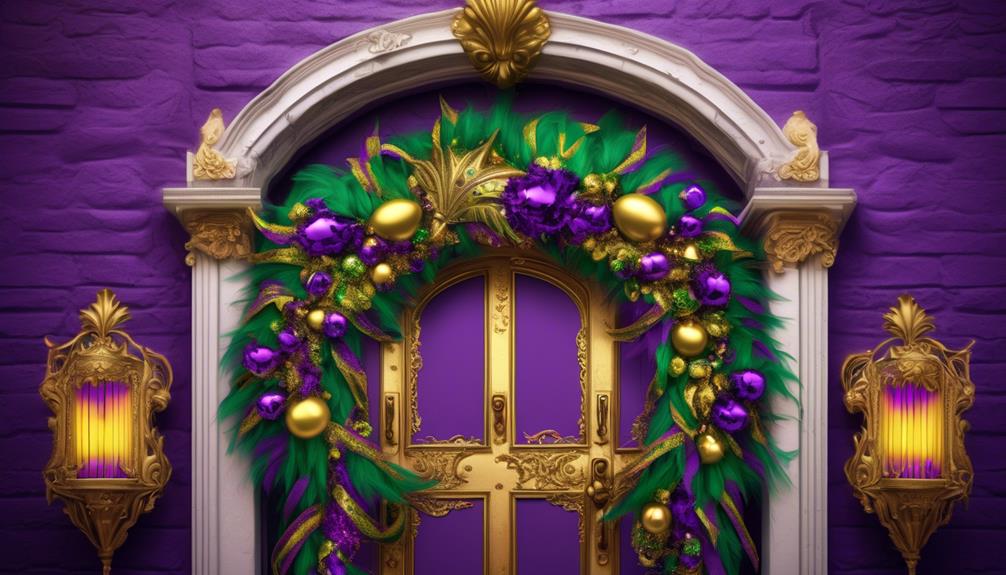
Let's create eye-catching sparkling door wreaths to add a touch of glamour and festivity to your Mardi Gras decor. Making a DIY wreath for Mardi Gras can be a fun and rewarding project. Here are some wreath decorating ideas to help you get started:
- Beaded Elegance: String colorful Mardi Gras beads around a foam or vine wreath base, securing them with hot glue. Add in some shimmering metallic beads for an extra touch of elegance.
- Feathery Flourish: Attach vibrant feathers in green, gold, and purple to the wreath using floral wire or hot glue. Layer the feathers for a lush and extravagant look.
- Glittering Accents: Sprinkle a foam or vine wreath with glitter in Mardi Gras colors. Secure the glitter with a clear sealant spray to prevent it from shedding. Then, add in some glittery Mardi Gras masks, fleur-de-lis ornaments, or decorative picks for a dazzling finish.
Creating your own sparkling door wreaths is a delightful way to showcase your creativity and bring the festive spirit of Mardi Gras to your home.
Masked Balloon Bouquets
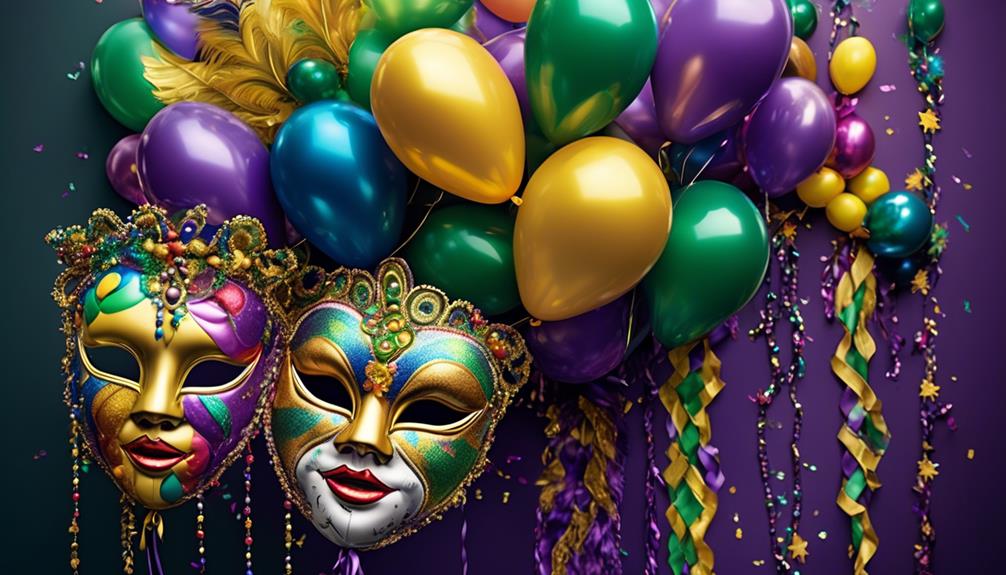
After adorning our doors with sparkling wreaths, we can enhance our Mardi Gras decor by creating vibrant and festive masked balloon bouquets. These balloon sculptures add a touch of whimsy and elegance to any masquerade party.
To craft these stunning bouquets, start by selecting an assortment of Mardi Gras colored balloons, such as purple, green, and gold. Use a variety of sizes to add visual interest. Next, inflate the balloons and tie them off, ensuring they're fully inflated for a beautiful effect.
Once you have your balloons ready, attach them to balloon sticks or lightweight wooden dowels. To create the masked effect, attach elegant masquerade masks to the top of each bouquet. Secure the masks by tying them to the sticks with colorful ribbons that complement the balloon colors. Consider adding glitter or sequins to the masks for an extra festive touch.
Arrange the finished balloon bouquets in strategic locations around your party space, such as near the entrance, the dance floor, or the food table. These vibrant and eye-catching decorations will surely delight your guests and elevate the festive atmosphere of your Mardi Gras celebration.
Jazz-Inspired Wall Decor

Exploring the rhythmic and colorful essence of jazz, we can infuse our Mardi Gras decor with captivating and vibrant wall art inspired by the soulful melodies and spirited energy of this musical genre. Jazz music, with its improvisational nature and rich history, provides a perfect backdrop for artistic inspiration as we create stunning wall decor for our Mardi Gras celebrations.
- Musical Notes Mural: Adorn your walls with a larger-than-life mural depicting swirling musical notes in vibrant Mardi Gras colors. Let the notes dance across the wall, capturing the vivacious spirit of jazz music and adding a dynamic focal point to your decor.
- Vintage Album Cover Display: Showcase vintage jazz album covers in stylish frames, creating a gallery wall that pays homage to the classic artistry of the genre. The striking visuals and evocative designs of these album covers will infuse your space with the timeless allure of jazz.
- DIY Jazz-Inspired Art: Get creative and make your own jazz-inspired art pieces using mixed media, incorporating elements like musical instruments, bold colors, and expressive brushstrokes. These unique creations will bring an authentic and personalized touch to your Mardi Gras wall decor, reflecting the improvisational and eclectic nature of jazz.
Frequently Asked Questions
Where Can I Find Affordable Mardi Gras Decorations?
We usually find affordable Mardi Gras decorations at online retailers and local stores. Online retailers offer a wide variety of Mardi Gras decorations at competitive prices, while local stores may have unique and affordable options.
For budget-friendly options, we often opt for DIY decorations. When seeking budget-friendly options, DIY decorations can be a fun and cost-effective way to add a personal touch to your Mardi Gras decor.
Are There Any Traditional Mardi Gras Symbols That I Should Include in My Decorations?
Traditional symbols like fleur-de-lis, masks, and beads are essential for DIY Mardi Gras decorations. Incorporating these symbols can add an authentic touch to your decor. Look for affordable options at craft stores or online to stay within budget.
Get creative with colors and patterns to make your decorations stand out. These symbols will bring the festive Mardi Gras spirit into your home without breaking the bank.
How Can I Incorporate Mardi Gras Decorations Into My Outdoor Space?
We can incorporate Mardi Gras decorations into our outdoor space by creating DIY Mardi Gras themed crafts. Hanging colorful banners, making festive wreaths, and crafting unique yard signs are great ways to bring the Mardi Gras spirit outside.
We can also use traditional Mardi Gras symbols like fleur-de-lis and masks to add authenticity to our outdoor decor.
What Are Some Creative Ways to Display Mardi Gras Decorations in My Home?
We've found that a creative centerpiece is a great way to showcase Mardi Gras decorations in your home.
You can make a DIY garland using colorful beads, feathers, and masks to really bring the festive spirit to any room.
Can I Make My Own Mardi Gras Decorations Using Items I Already Have at Home?
Absolutely, we can create our own Mardi Gras decorations using household items. DIY decorations aren't only budget-friendly, but they also add a personal touch to our celebrations.
By repurposing items like colorful fabric, beads, and paper, we can craft vibrant and festive décor. From handmade masks to garlands, the possibilities are endless.
Let's get creative and infuse our homes with homemade Mardi Gras spirit!
Conclusion
So, let's get ready to jazz up our Mardi Gras celebrations with these fabulous decorations!
With colorful masks, festive garlands, vibrant feather boas, glittery centerpieces, homemade jester hats, sparkling wreaths, masked balloon bouquets, and jazz-inspired wall decor, our party is sure to be a sight to behold.
Let's bring the spirit of Mardi Gras to life with these dazzling and lively decorations that will transform any space into a festive and vibrant celebration!
- About the Author
- Latest Posts
Introducing Ron, the home decor aficionado at ByRetreat, whose passion for creating beautiful and inviting spaces is at the heart of his work. With his deep knowledge of home decor and his innate sense of style, Ron brings a wealth of expertise and a keen eye for detail to the ByRetreat team.
Ron’s love for home decor goes beyond aesthetics; he understands that our surroundings play a significant role in our overall well-being and productivity. With this in mind, Ron is dedicated to transforming remote workspaces into havens of comfort, functionality, and beauty.
-

 Retreat3 weeks ago
Retreat3 weeks agoIncorporating Biophilic Design in Your Retreat Center
-

 Retreat3 weeks ago
Retreat3 weeks agoDesigning a Retreat Center Kitchen: From Layout to Equipment
-

 Southeast Asia Decor4 weeks ago
Southeast Asia Decor4 weeks agoHistorical Feng Shui Color Schemes in Interiors
-

 Retreat3 weeks ago
Retreat3 weeks agoDIY Rustic Decor Ideas for a Cozy Retreat Atmosphere
-

 Southeast Asia Decor4 weeks ago
Southeast Asia Decor4 weeks agoFeng Shui Color Palettes for Your Home
-

 Southeast Asia Decor2 weeks ago
Southeast Asia Decor2 weeks agoUltimate Guide to Harmonious Furniture Placement
-

 Retreat4 weeks ago
Retreat4 weeks agoDIY Spa Treatments You Can Offer at Your Retreat Center
-

 Retreat4 weeks ago
Retreat4 weeks agoCreating an Indoor Garden for Year-Round Greenery




























